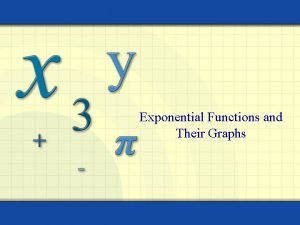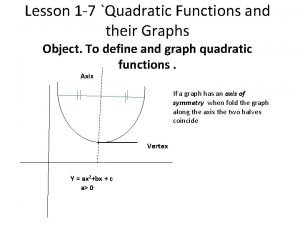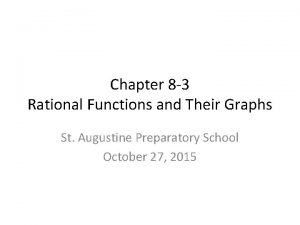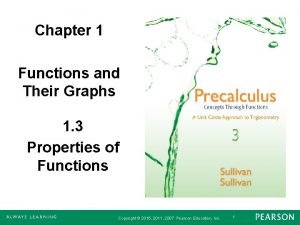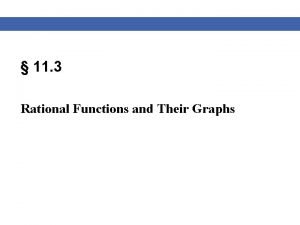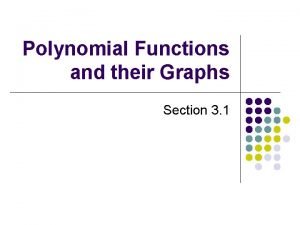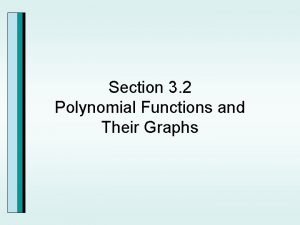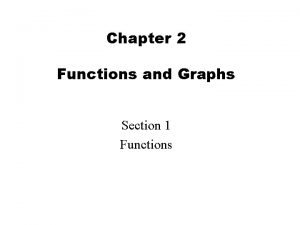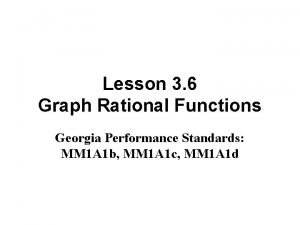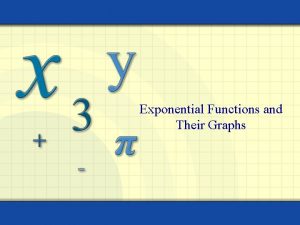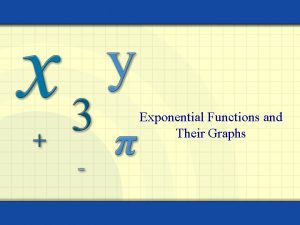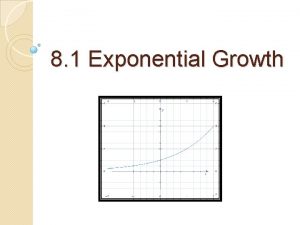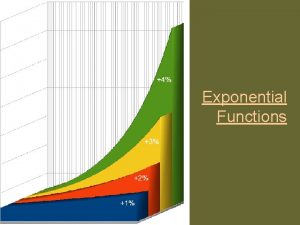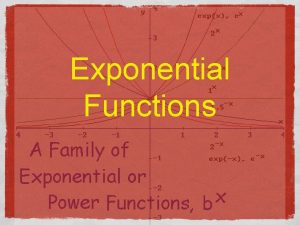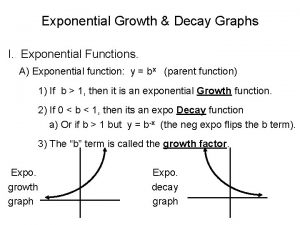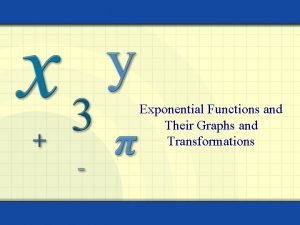Exponential Functions and Their Graphs The exponential function















- Slides: 15

Exponential Functions and Their Graphs

The exponential function f with base a is defined by f(x) = ax where a > 0, a 1, and x is any real number. For instance, f(x) = 3 x and g(x) = 0. 5 x are exponential functions. 2

The value of f(x) = 3 x when x = 2 is f(2) = 32 = 9 The value of f(x) = 3 x when x = – 2 is f(– 2) = 3– 2 = The value of g(x) = 0. 5 x when x = 4 is g(4) = 0. 54 = 0. 0625 3

The graph of f(x) = bx, b > 1 Exponential Growth Function y 4 Range: (0, ) (0, 1) x 4 Domain: (– , ) Horizontal Asymptote y=0 4

The graph of f(x) = bx, 0 < b < 1 y Exponential Decay Function 4 Range: (0, ) (0, 1) x 4 Domain: (– , ) Horizontal Asymptote y=0 5

Exponential Function • • 3 Key Parts 1. Y-intercept 2. Horizontal Asymptote 3. Growth or Decay 6

Manual Graphing • Lets graph the following together: • f(x) = 2 x Copyright © by Houghton Mifflin Company, Inc. All rights reserved. 7

Example: Sketch the graph of f(x) = 2 x. x -2 -1 0 1 2 f(x) (x, f(x)) ¼ (-2, ¼) ½ (-1, ½) 1 (0, 1) 2 (1, 2) 4 (2, 4) y 4 2 x – 2 Copyright © by Houghton Mifflin Company, Inc. All rights reserved. 2 8

Definition of the Exponential Function The exponential function f with base b is defined by f (x) = bx or y = bx Where b is a positive constant other than and x is any real number. Here are some examples of exponential functions. f (x) = 2 x g(x) = 10 x Base is 2. Base is 10. Copyright © by Houghton Mifflin Company, Inc. All rights reserved. h(x) = 3 x Base is 3. 9

Calculator Comparison • Graph the following on your calculator at the same time and note the trend • y 1 = 2 x • y 2= 5 x • y 3 = 10 x 10

When base is a fraction • Graph the following on your calculator at the same time and note the trend • y 1 = (1/2)x • y 2= (3/4)x • y 3 = (7/8)x 11

Transformations Involving Exponential Functions Transformation Equation Description Horizontal translation g(x) = bx+c • Shifts Vertical stretching or shrinking g(x) = cbx Multiplying y-coordintates of f (x) = bx by c, • Stretches the graph of f (x) = bx if c > 1. • Shrinks the graph of f (x) = bx if 0 < c < 1. Reflecting g(x) = -bx g(x) = b-x • Reflects Vertical translation g(x) = bx+ c • Shifts the graph of f (x) = bx to the left c units if c > 0. • Shifts the graph of f (x) = bx to the right c units if c < 0. the graph of f (x) = bx about the x-axis. • Reflects the graph of f (x) = bx about the y-axis. the graph of f (x) = bx upward c units if c > 0. • Shifts the graph of f (x) = bx downward c units if c < 0. 12

Example: Sketch the graph of g(x) = 2 x – 1. State the domain and range. The graph of this function is a vertical translation of the graph of f(x) = 2 x down one unit. y f(x) = 2 x 4 2 Domain: (– , ) x Range: (– 1, ) y = – 1 13

Example: Sketch the graph of g(x) = 2 -x. State the domain and range. y The graph of this function is a reflection the graph of f(x) = 2 x in the yaxis. f(x) = 2 x 4 Domain: (– , ) Range: (0, ) x – 2 2 14

Discuss these transformations • • • y = 2(x+1) Left 1 unit y = 2 x + 2 Up 2 units y = 2 -x – 2 Reflect over y-axis, then down 2 units 15
 Exponential functions and their graphs
Exponential functions and their graphs Polynomial end behavior chart
Polynomial end behavior chart Horizontal asymptotes rules
Horizontal asymptotes rules Quadratic functions and their graphs
Quadratic functions and their graphs Removable and nonremovable discontinuity
Removable and nonremovable discontinuity Chapter 1 functions and their graphs
Chapter 1 functions and their graphs Sketch the graph of the following rational function
Sketch the graph of the following rational function Common functions and their graphs
Common functions and their graphs Polynomial vocabulary
Polynomial vocabulary Polynomial functions and their graphs
Polynomial functions and their graphs Analyzing graphs of polynomial functions calculator
Analyzing graphs of polynomial functions calculator Chapter 2 functions and their graphs answers
Chapter 2 functions and their graphs answers Rational functions and their graphs
Rational functions and their graphs Lesson 3 rational functions and their graphs
Lesson 3 rational functions and their graphs Practice a investigating graphs of polynomial functions
Practice a investigating graphs of polynomial functions Investigating graphs of polynomial functions
Investigating graphs of polynomial functions
